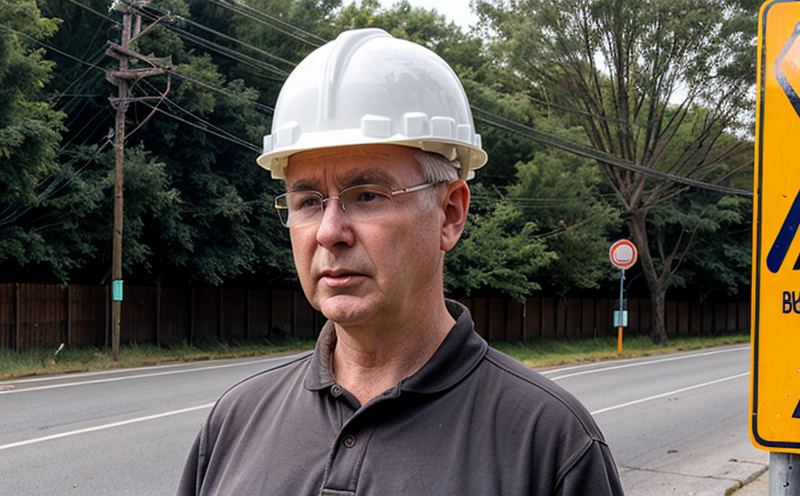EN 1793-1 Roadside Noise Barrier Acoustic Performance Testing
The EN 1793-1 standard is specifically designed to evaluate the acoustic performance of roadside noise barriers installed along highways and other similar roadways. This testing ensures that noise barriers meet regulatory requirements for reducing environmental noise, thereby protecting public health and improving quality of life in residential areas adjacent to busy roads.
The standard applies to various types of sound barriers including concrete, metal, wood, and composite structures. The acoustic performance is evaluated using a combination of laboratory and on-site measurements. Laboratory testing involves the use of specialized chambers that simulate real-world conditions, while on-site tests are conducted under actual operational scenarios to ensure accuracy.
The primary purpose of this test is to determine whether the barrier effectively reduces noise levels in accordance with specified criteria. This ensures that the barrier not only meets regulatory requirements but also provides tangible benefits to local communities by reducing excessive noise pollution. The testing process involves several key steps, including selecting appropriate locations for measurement, conducting pre-installation measurements, installing the barrier, and then performing post-installation measurements.
Preparation of specimens is crucial before any testing can commence. This includes ensuring that all materials used comply with relevant specifications and standards. For instance, concrete barriers must meet certain compressive strength requirements as per ASTM C39/C39M-18 or EN 12350-2:2014, while metal barriers should adhere to ISO 9653-1:2017 for galvanic corrosion resistance. Proper installation is also critical; deviations from recommended practices could lead to inaccurate results.
Once the barrier has been installed, on-site measurements are taken using advanced acoustic equipment such as sound level meters (ANSI S12.8-2015), octave band analyzers (IEC 61672-1:2013), and directional microphones (ISO 9614-1:2016). These instruments allow for precise quantification of sound pressure levels at different locations along the barrier line. Post-installation measurements typically take place within a specific window after installation to account for any settling effects.
The results from these tests are then analyzed against established criteria outlined in EN 1793-1. Compliance with these standards indicates that the noise barrier has successfully reduced ambient noise levels by an acceptable margin, thus fulfilling its intended purpose effectively. Non-compliance may indicate either issues with design or installation which would need correction prior to final acceptance.
Real-world applications of this testing are numerous and varied. Governments worldwide increasingly recognize the importance of reducing environmental noise pollution through strategic placement of noise barriers along highways and busy roadsides. By adhering to EN 1793-1 guidelines during design, procurement, construction, and maintenance processes, organizations can ensure compliance with local regulations while simultaneously contributing positively towards healthier urban environments.
- Ensures effective reduction of environmental noise pollution
- Meets regulatory requirements for public health protection
- Promotes improved quality of life in residential areas
- Achieves higher levels of customer satisfaction by addressing community concerns proactively
Why Choose This Test
Selecting the appropriate noise barrier for your project is crucial, and choosing EN 1793-1 Roadside Noise Barrier Acoustic Performance Testing provides several advantages over other options. Firstly, it offers a comprehensive approach to evaluating both laboratory and field performance of the barriers, ensuring that they meet stringent acoustic standards.
Secondly, this testing ensures compliance with international regulations such as EN 1793-1:2018, making it easier for your organization to comply with local laws and ordinances. This can significantly reduce the risk of penalties or other legal issues associated with non-compliance.
Thirdly, by selecting EN 1793-1 Roadside Noise Barrier Acoustic Performance Testing, you gain access to expert knowledge and experience in the field, which can greatly enhance your project’s success. Our team comprises highly qualified professionals who understand the nuances of this testing method and can provide valuable insights throughout the process.
Furthermore, this testing allows for early identification of potential problems that could arise during or after installation, enabling timely corrective actions to be taken before they become major issues. This proactive approach helps minimize delays and costs associated with rework or replacement.
Lastly, choosing EN 1793-1 Roadside Noise Barrier Acoustic Performance Testing demonstrates a commitment to quality and sustainability, which can enhance your organization’s reputation among clients and stakeholders. It shows that you are serious about delivering high-quality products and services that contribute positively towards creating healthier living environments.
International Acceptance and Recognition
The EN 1793-1 standard is widely recognized across Europe and beyond for its rigorous approach to evaluating the acoustic performance of roadside noise barriers. Its acceptance in various countries underscores its credibility as a reliable tool for ensuring compliance with local regulations concerning environmental noise control.
Many governments have adopted this standard due to its ability to provide accurate measurements that reflect real-world conditions accurately. This ensures that any proposed changes or improvements are based on sound data rather than assumptions alone. For example, in Germany and the Netherlands, EN 1793-1 has become an integral part of their national guidelines for constructing new noise barriers.
Moreover, international organizations such as the World Health Organization (WHO) have endorsed this standard due to its alignment with global goals aimed at reducing urban noise pollution. By aligning local practices with internationally recognized benchmarks, governments can better address public health concerns while promoting sustainable development.
The widespread adoption of EN 1793-1 also facilitates seamless collaboration between different jurisdictions. Consultants and contractors working on projects spanning multiple borders can rely on consistent methodologies regardless of geographical location. This promotes efficiency in project planning, execution, and monitoring.
In summary, selecting the appropriate testing method is essential for ensuring compliance with international standards while promoting best practices within your organization. EN 1793-1 Roadside Noise Barrier Acoustic Performance Testing offers numerous benefits that make it an ideal choice for organizations seeking to implement effective noise barriers successfully.





